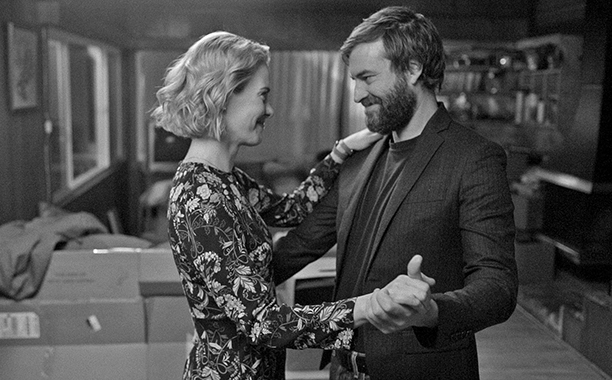ESSEX WRITER and musician Ross PALMER takes a look at the effect music is used in film, and the importance of understanding characters, tone and themes when deciding on what songs to use throughout.
Released in 2016, Blue Jay stars Mark Duplass and the always-excellent Sarah Paulson as Jim and Amanda, high-school sweethearts who run into each other after 20 years when Jim returns to their hometown to renovate and sell his late mother’s home. The movie is basically a two-hander for Duplass and Paulson, and follows their characters for 24 hours in which relive their past together while the unresolved issues between them force their way to the surface.
During the evening, they buy some beers and go through Jim’s collection of mementoes from their relationship. At one point, he puts on Annie Lennox’s No More “I Love You”s – a moderate hit in the US but probably instantly familiar to anyone who grew up in the UK in the 1990s, where Lennox’s Diva and Medusa albums spawned multiple big hit singles in the first half of the decade.
When the song starts, Jim and Amanda are just goofing around, singing along in falsetto and doing knowingly silly dances. But as the song does its Proustian work on them, they begin to share meaningful eye and bodily contact. The song ends with their arms still around each other, the camera lingering for a second on Amanda’s hand as the light catches the ring on her finger.

It’s a wonderful scene, and a huge part of why it works as well as it does is the astute choice of song on the part of the music supervisory team of Maggie Phillips and Christine Greene Roe.
It would have been easy for them to prove their hipster cred by putting something obscure on the soundtrack and have Jim and Amanda dance to that. Some heartstring-tugging indie ballad. Sebadoh’s Soul and Fire, something like that. Or, going the other way, they could have chosen an enduring radio staple hit that strikes the right thematic chord and immediately evokes the era. No Doubt’s Don’t Speak, perhaps.
The “I haven’t heard this in ages” feeling is an important part of what makes No More “I love You”s such an astute choice for the scene.
But choices like that wouldn’t have been true to the characters. On the evidence of the skits they recorded together on a cassette player, Jim and Amanda may well have been theatre kids when they were teenagers, more into Lloyd Webber than Lloyd Cole – not uncool, necessarily, but perhaps not the hippest kids at their school. No More “I Love You”s is exactly the kind of thing people like that might have had as “their song”: a little arty, a little camp and a little dramatic. The song chosen for the scene needed to have been a pop hit, but not an inescapable one that’s still on the radio now. The “I haven’t heard this in ages” feeling is an important part of what makes No More “I Love You”s such an astute choice for the scene.
So is the rare and difficult high-wire act the song itself pulls off. The falsetto backing vocals and the grandiosity of its arrangement are knowingly, almost provocatively, absurd, but the emotions underpinning Lennox’s performance feel real – earnest, even. The song is preposterous, but it’s also deadly serious. Its emotional state is complicated, and keeps shifting. This instability is reflected in Jim and Amanda’s move from awkwardness at the beginning of the scene (which they attempt to disguise with humour), to vulnerability, to deep connection at the end, undercut by the knowledge that they can’t recapture who they were as teenagers; the ring on Amanda’s is just a visible sign of this impossibility. It’s left to us to wonder what else may be in the way, and if there really will be no more “I love you”s.
Whether diegetic or not, the best musical choices are driven by character and emotion. They prompt us to think about what a song means in context of plot, character and theme. Blue Jay is a fine film throughout, no question, but when Jim and Amanda dance to No More “I Love You”s, it’s transfixing.
Ross Palmer is a London-based writer and musician originally from Leigh-on-Sea, writing articles on all things music as well as playing in the band Watertown Carps alongside his solo music. @rossjpalmer
